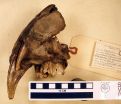(Press-News.org) Scientists have identified a group of genetic mutations in patients with aplastic anemia, which likely will help doctors optimize treatment for this rare and deadly blood condition. The study, appearing in the New England Journal of Medicine, could lead to tailor-made treatment plans for aplastic anemia patients as part of the emerging precision medicine movement. It is the largest study of its kind to examine gene mutations in aplastic anemia, the scientists note.
The work involved researchers from the National Institutes of Health, the Cleveland Clinic, Cleveland, OH, and Kanazawa University, Kanazawa, Japan. Neal S. Young, chief of the hematology branch at the NIH's National Heart, Lung, and Blood Institute, was the study's co-leader. Almost 1,000 new cases of aplastic anemia occur each year in the United States alone. Although the disease can affect anyone, children and young adults make up the majority of cases. Stem cells in the bone marrow are normally responsible for producing blood. In aplastic anemia, the body's immune system appears to destroy these stem cells.
Historically, severe aplastic anemia was almost always fatal due to infections and bleeding. Today, bone marrow transplantation can cure the condition, but it is not widely available and requires hard-to-find donors. Doctors generally treat aplastic anemia effectively using immunosuppressives--drugs that prevent the immune system from attacking bone marrow--allowing recovery of the patient's own marrow and long-term survival. However, about 15 percent of patients on immunosuppressives develop cancer of the blood--acute leukemia and myelodysplastic syndromes--months or years following treatment.
For the current study, researchers used next-generation DNA sequencing, a way of rapidly analyzing genes, to examine the genomes of blood samples from more than 400 patients with aplastic anemia, enrolled from centers specializing in the treatment of bone marrow failure. Within bone marrow, stem cells can differentiate into mature blood cells or self-renew, meaning make more stem cells. In about a third of patients with aplastic anemia, stem cell "clones" appear with mutations in a few specific genes (DNMT3A and ASXL1), genes previously identified as mutated also in blood cancers. Patients with these mutations do not fare as well long term as those without mutations, or, patients with mutations in a few other apparently favorable genes (BCOR and PIGA, for example).
In the future, genomic screening at diagnosis should allow care providers to choose the best treatment option or monitor for the emergence of clone stem cells. The unfavorable genes, DNMT3A and ASXL1, are frequently mutated in myeloid leukemia and myelodysplastic syndromes, and they are also mutated in a substantial number of older individuals without a blood disease.
Using specimens collected annually in patients seen at Dr. Young's bone marrow failure clinic at the NIH Clinical Center, the investigators show that patients can support good blood cell production for many years from only a few stem cell clones, which can contain many unfavorable mutations. Potential scientific questions from this research relate to the origin and function of stem cell clones and to whether they could be used to predict future outcomes.
INFORMATION:
Neal S. Young, M.D., chief of the hematology branch at NHLBI, is available to comment on the findings and implications of this research.
CONTACT: For more information or to schedule an interview, please contact the NHLBI Office of Science Policy, Engagement, Education, and Communications at 301-496-4236 or nhlbi_news@nhlbi.nih.gov .
Part of the National Institutes of Health, the National Heart, Lung, and Blood Institute (NHLBI) plans, conducts, and supports research related to the causes, prevention, diagnosis, and treatment of heart, blood vessel, lung, and blood diseases; and sleep disorders. The Institute also administers national health education campaigns on women and heart disease, healthy weight for children, and other topics. NHLBI press releases and other materials are available online at http://www.nhlbi.nih.gov.
About the National Institutes of Health (NIH): NIH, the nation's medical research agency, includes 27 Institutes and Centers and is a component of the U.S. Department of Health and Human Services. NIH is the primary federal agency conducting and supporting basic, clinical, and translational medical research, and is investigating the causes, treatments, and cures for both common and rare diseases. For more information about NIH and its programs, visit http://www.nih.gov.
NIH...Turning Discovery Into Health
DALLAS, July 1, 2015 -- While menopause is commonly considered a risk factor for heart disease, menopausal women had a lower risk of dying from heart attack than men; however, this difference was less pronounced among blacks, according to research in the Journal of the American Heart Association.
In the first study to compare men and women and how menopause types impact risk of heart attack, researchers studied 23,086 black and white adults over age 45 and found:
White women who had surgical-induced menopause had a 35 percent reduced risk of non-fatal heart attacks ...
As we walk along a forest path, the soil beneath our feet seems like a uniform substance. However, it is an intricate network of soil particles, pores, minerals, soil microbes, and more. It is awash in variety.
Soil is a living, dynamic substance, and the microbial life within it is crucial to providing plant life with the food they need to grow. The microbes can be bacteria or fungi, but both need space--the pores--for a good living environment.
Soil particles that clump together are aggregates. These are the architectural building blocks of soil. Their presence ...
Alexandria, VA - Analyzing thousands of records, researchers have reinforced the claim that for marine life, bigger has been better for the last 542 million years. The study examined Cope's rule - the idea, named for paleontologist Edward Drinker Cope, that species evolve to larger sizes over time.
With the help of undergraduate students and high-school interns, the researchers compiled information on five major marine phyla, including arthropods, brachiopods, chordates, echinoderms and mollusks. Find out how much bigger things got in the June issue of EARTH Magazine: ...
New research shows that the fearsome teeth of the saber-toothed cat Smilodon fatalis fully emerged at a later age than those of modern big cats, but grew at a rate about double that of their living relatives. The findings, published today in the journal PLOS ONE and based on a new technique that combines isotopic analysis and x-ray imaging, for the first time provide specific ages for developmental events in Smilodon, notably in their teeth. The study estimates that the eruption rate of S. fatalis's permanent upper canines was 6 millimeters per month--double the growth ...
Statins are a hugely popular drug class used to manage blood cholesterol levels and reduce the risk of heart disease. Previous studies had raised questions about adverse behavioral changes with statins, such as irritability or violence, but findings with statins have been inconsistent. In the first randomized trial to look at statin effects on behavior, researchers at the University of California, San Diego School of Medicine report that aggressive behavior typically declined among men placed on statins (compared to placebo), but typically increased among women placed on ...
A newly-discovered, 48-million-year-old fossil, known as a "Jesus lizard" for its ability to walk on water, may provide insight into how climate change may affect tropical species, according to a study published July 1 in the open-access journal PLOS ONE by Jack Conrad from American Museum of Natural History.
Modern relatives of the Jesus lizard live in an area stretching from central Mexico to northern Colombia, flourishing in the higher temperatures found at the equator. Members of various animal, plant, fungal, and other clades currently confined to the tropics or ...
An international team of researchers has found some of the first solid evidence that narcolepsy may be a so-called "hit-and-run" autoimmune disease.
The researchers sought to determine why, of two different flu vaccines widely deployed during the 2009 swine flu pandemic, only one was associated with a spike in the incidence of narcolepsy, a rare sleep disorder.
A paper describing their findings will be published July 1 in Science Translational Medicine. Lawrence Steinman, MD, a professor of pediatrics and of neurology and neurological sciences, is the senior author. ...
While most Americans do not support policies designed to increase distribution of naloxone - a medication that reverses the effects of a drug overdose - certain types of educational messages about its lifesaving benefits may bolster support for its use, new Johns Hopkins Bloomberg School of Public Health research suggests.
In a report published July 1 in the journal PLOS ONE, the researchers say that combining educational messages about naloxone with sympathetic narratives about people who could have been saved had the drug been available could be key to increasing support ...
Widely hailed as 'green' sources of renewable energy, hydroelectric dams have been built worldwide at an unprecedented scale. But research from the University of East Anglia reveals that these major infrastructure projects are far from environmentally friendly.
A study published today in PLOS ONE reveals the drastic effects of the major Amazonian Balbina Dam on tropical rainforest biodiversity.
The research reveals a loss of mammals, birds and tortoises from the vast majority of islands formed by the creation of the vast Balbina Lake, one of the world's largest hydroelectric ...
Vitamin B12 supplements offer no benefits for neurological or cognitive function in older people with moderate vitamin B12 deficiency, according to a new study published in the American Journal of Clinical Nutrition.
Around one sixth of people in the UK aged over 75 have vitamin B12 deficiency, which when severe can lead to significant problems in the nervous system including muscle weakness, problems with walking, tiredness, and pins and needles, as well as depression and problems with memory and other important everyday cognitive functions. Vitamin B12 is found in everyday ...


